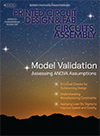New Products
Tridak Model 826 disposable fluid path valve features adjustable suck-back control. Prevents material from forming at the dispense tip with low-viscosity fluids. Pinch valve also features disposable fluid path technology. Fluid tubing is replaceable; is available in two sizes and a variety of materials. Reportedly eliminates expensive seal-kit maintenance. Is said to be ideal for all low-to-high viscosity materials. Possesses flow control and an over-stroke adjustment that prevents tubing damage. Model 345 valve controller is best suited for actuation of this valve.
Tridak, www.tridak.com
Axis Series automated filling system fills grease, pastes, etc. into cavities and onto components, reportedly to accurate and repeatable volumes. Is self-contained and includes a dual memory processor with compact flash card. Comes as a benchtop system for low- to mid-volume applications. A menu-driven LCD/touchpad interface controls the machine and manages internal files. Is network connectable, as well as RS-232; includes a barcode reader input. Containers are processed on pallets (two are included); may unload/load one pallet, while the machine is filling the other. Includes batch counters, cycle timers and an internal history file. Available with programmable auger valve, peristaltic pump, programmable shot pump, pressure pot, valve, etc. A continuous path pattern may be dispensed in all three axes.
Dispense Works, www.dispenseworks.com
RDS 2100 and RDS 3000 drying systems for solar cell metallization consist of a combination of either five or seven IR zones and one central convection zone. Guarantee safe transport through the oven, either via mesh belt or with pin chain up to three lanes. Conveyor of the heating zone can be separated from that of the cooling zone; reportedly no latent heat is carried into the cooling area. Have belt speeds up to 6 m./min. and throughputs of up to 5700 wph.
Rehm Thermal Systems, www.rehm-group.com
Model 765 needle valve is said to be ideally suited for non-reactive adhesives, silicone oils, inks and solvents. Can be used in processes such as device assembly, packaging, optics assembly and building PCBs. Offers low maintenance and precision flow control. Is easily integrated into process automation and robotics. Optimal operation is achieved using Model 345 valve controller.
Tridak, www.tridak.com
The Integrated Process and Stencil Support (iPASS) system targets defect reduction and Lean manufacturing principles. Is said to provide upfront design for manufacturability support; offers a spectrum of stencil technology and related tooling; provides comprehensive process management. Duplicates stencils and processes from one line to the next, and throughout global manufacturing network. Includes stencils, screens, blades and related tooling. Provides CAD services, including design review and check plots, design library standardization and management, and weekly reporting. Includes training, managed product rollout, order confirmation and on-time delivery, and data reporting.
Photo Stencil, www.photostencil.com
3M Electronic Solutions Division, www.3M.com/electronics
Press Releases
- Altus Partners with Sellectronics to Enhance Manufacturing Capabilities with PVA Delta 8 System
- ITW EAE Celebrates Major Milestone in Domestic Manufacturing Expansion
- Micro Technology Services Selects PBT Works CompaCLEAN III for Advanced PCB Cleaning Performance
- Indium Corp. is Electrifying the Future with Advanced Materials Solutions at Productronica


